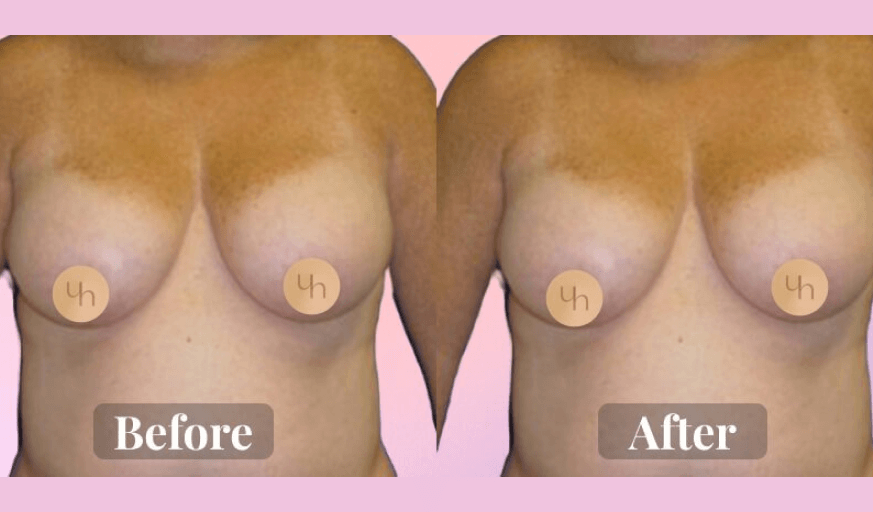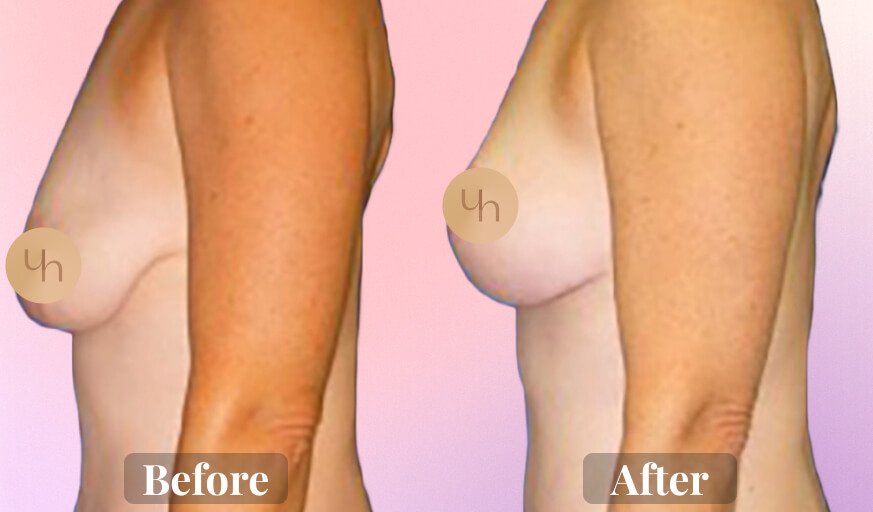Breast Lift

For many women, their breasts play a significant role in their sense of beauty and confidence. However, aging, childbirth, or weight loss can cause the breasts and nipples to sag over time.
A breast lift, or mastopexy, is a cosmetic procedure designed to elevate the breasts and improve their shape for a more youthful and lifted appearance. This surgery removes excess skin, tightens the underlying tissue, and creates a firmer, rounder contour. Additionally, it can reposition the nipple-areolar complex and adjust the size of enlarged areolas for a more proportionate and balanced look.
Breast Lift Techniques
Four commonly used breast lift techniques include crescent, periareolar, vertical, and anchor.
Crescent Breast Lift
Patients with mild sagging may be suitable candidates for a crescent breast lift. This technique involves making an incision along the upper half of the areola’s outer edge to remove a crescent-shaped section of tissue above it. Once the incision is closed, the lower portion of the breast is gently lifted, with any scarring discreetly hidden along the natural border of the areola’s darker pigmentation.
Periareolar Breast Lift
Recommended for: Mild sagging
The periareolar breast lift, often referred to as a “donut lift,” provides a gentle elevation of the breasts. This technique involves making a circular incision around the outer edge of the areola to remove a donut-shaped section of tissue. Scarring is minimal and remains well-concealed along the natural border of the areola.
Anchor Breast Lift
Severe cases of breast ptosis are most effectively treated with the anchor incision, also known as the inverted T incision. This method involves three incisions to allow for the removal of a significant amount of excess tissue and provide the surgeon with optimal access to the underlying structures, which can be lifted and secured with internal sutures.
The first incision encircles the areola, the second runs vertically from the areola to the breast crease, and the third extends horizontally along the base of the breast fold. This technique achieves the greatest lift and can dramatically reshape the breasts, though it does result in slightly more scarring due to the multiple incisions. Over time, scarring fades significantly—usually within a year—and is discreetly concealed along the breast fold and the areola’s edge.
Vertical Breast Lift
Patients with moderate breast ptosis, or sagging, are often ideal candidates for a vertical breast lift, commonly referred to as a “lollipop lift” due to the shape of the incision. This procedure involves two incisions: one encircling the outer edge of the areola and a second vertical incision extending from the bottom of the areola to the inframammary fold, or breast crease. These incisions allow the surgeon to reposition the underlying breast tissue and remove excess tissue, lifting the entire breast mound to a higher, more youthful position on the chest.
Benefits
A breast reduction has numerous benefits which include:
- Long-term results
- Improved cleavage
- Better-fitting clothing and the ability to wear less constricting bras
- Improved breast placement, projection, and contours
Ideal Candidates
You may be a good candidate for breast lift surgery if:
- You have generally good health
- Your nipples are oriented downwards and are below the breast crease
- You are content with the size of your breasts
- You experience mild to severe breast ptosis
If you are an active smoker, you may not be a good candidate for breast lift surgery.
Personal Consultation
During your consultation, we will talk about your goals for breast lift surgery and identify the most effective approach to achieve them. We’ll also share before-and-after photos of previous patients who have undergone the procedure, giving you a better sense of potential results and outcomes for your own surgery. If you’re considering whether breast lift surgery is right for you, reach out today to schedule a consultation with Dr. Hasanov.
Preparation
To achieve the best results from your breast lift surgery, it’s essential to carefully follow both pre- and post-operative instructions. To prepare for the procedure, you should:
- Schedule a mammogram to ensure a comprehensive evaluation.
- Avoid medications, supplements, and vitamins that thin the blood, such as aspirin, ibuprofen, NSAIDs, Vitamin E, and ginkgo biloba, as they can increase bleeding and swelling during recovery.
- Arrange for a trusted friend or family member to drive you to and from the procedure.
- Quit smoking, avoiding cigarettes and nicotine-based products for at least four weeks before surgery to support optimal healing.
Procedure
Each breast lift surgery is tailored to the individual needs of the patient, taking into account factors such as natural breast size and shape, areola positioning, and skin elasticity. The procedure typically includes the following steps:
- Anesthesia: The surgery is performed under general anesthesia to ensure patient comfort.
- Incisions: The surgeon will make incisions on each breast based on the degree of sagging and the desired results. The incision type may be crescent, periareolar, vertical, or anchor-shaped.
- Reshaping and Repositioning: The breast tissue is lifted, reshaped, and repositioned as needed. The nipple-areolar complex is moved to a higher position, and the areolas may be resized for a more balanced appearance. Excess skin is removed to create a firmer, tighter contour.
- Closing Incisions: The incisions are carefully closed with stitches. While scars are a natural part of the healing process, they typically fade and reach their final appearance within a year, influenced by individual genetics and medical history.
After the procedure, you will awaken with your chest supported by bandages and a compression garment to reduce swelling and enhance comfort.
Recovery
Most of our breast lift patients typically feel ready to return to work within one to two weeks after the procedure. Bruising and swelling generally subside within three to six weeks. Light activities, such as walking, are encouraged to support recovery. It’s important for patients to prioritize adequate rest, avoid heavy lifting, take prescribed medications as directed, wear supportive undergarments, and attend all follow-up appointments to ensure optimal healing and results.
Results
On average, breast lift results last between 10 and 15 years, though many patients continue to enjoy noticeable improvements beyond this timeframe. It’s important to maintain realistic expectations, as natural factors like gravity, aging, and lifestyle changes will still influence breast appearance over time.
To help maintain your results, consider the following:
- Wear supportive bras: Proper support, especially during exercise, can reduce strain on breast tissue.
- Maintain a stable weight: Significant weight fluctuations can affect breast shape and firmness.
- Follow a healthy lifestyle: A balanced diet, regular exercise, and avoiding smoking can support overall skin and tissue health.



